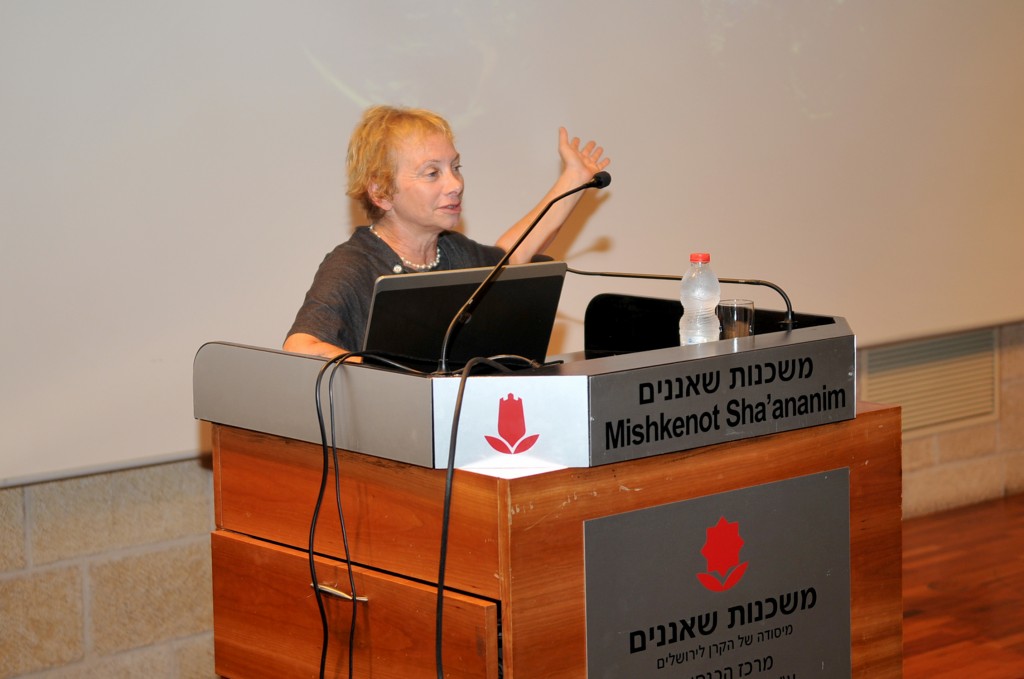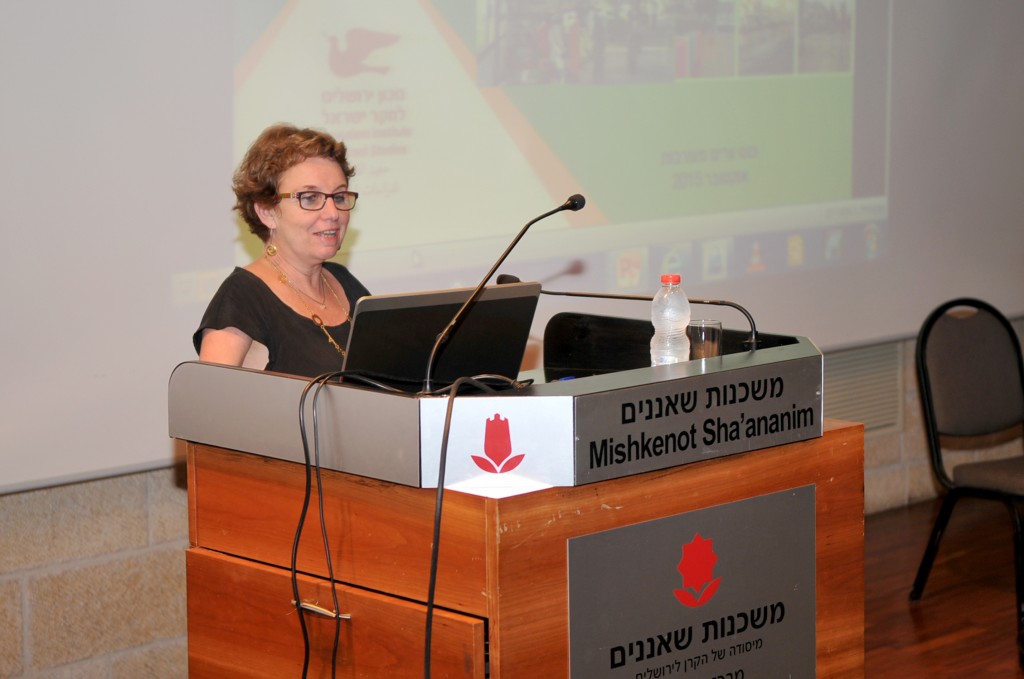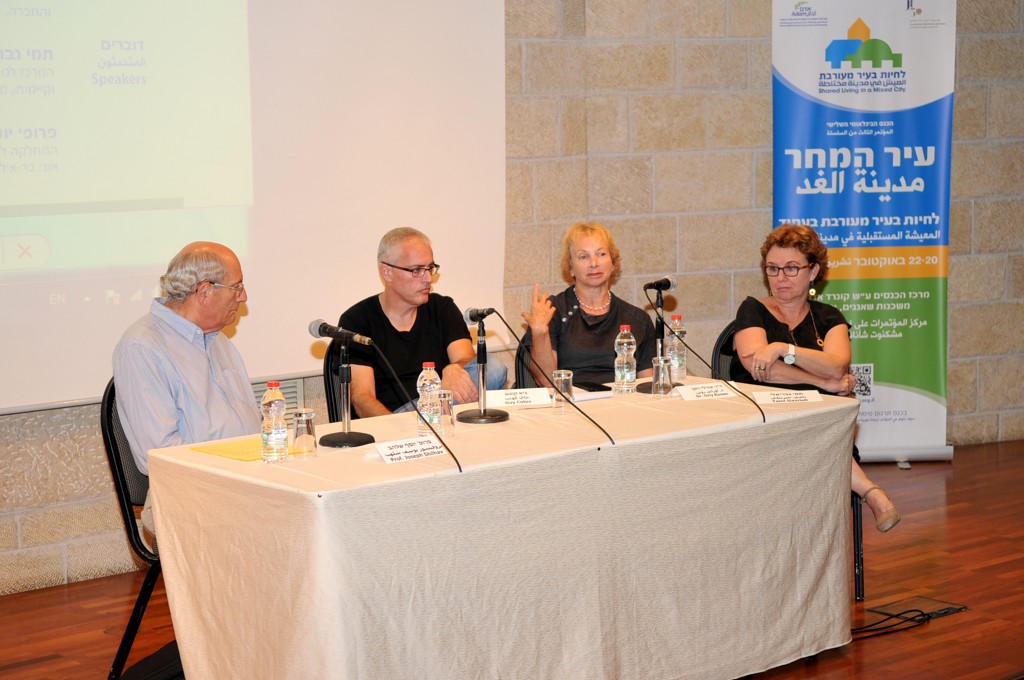3rd Plenary Session: SustainabilityA�A�A�A�A�A�A�A�A�A�A�A�
Moderator: Guy Cotev, Reporter and editor, Voice of Israel;
Speakers: A�A�A�A�A�A�A�A�A�A�A�A�
Dr. Orly Ronen, Head of the Urban Sustainability and Innovation Lab., Porter School of Environmental and Social Studies, Tel Aviv University;
Tami Gavrieli, Director of the Sustainability Research Center, The Jerusalem Institute for Israel Studies;
Prof. Joseph Shilhav, Department of Geography and Environment, Bar-Ilan University
A�
Guy Cotev
We are going to discuss sustainability in the world of tomorrow, but in Israel the environment is stuck in the world of yesterday. Nevertheless, the environment can bridge and mediate in regions of conflict where other things fail. A good example is Dr. Yossi Leshema��s owl project. He works with Palestinian, Jordanian and Israeli activists. Examples of environmental issues that require regional cooperation are polluting factories and polluted rivers where water is flowing from the West Bank.A� As a result of these problems, partnerships were formed to improve the situation. The separation barrier doesna��t stop the birds, the air that we breathe or the water we consume.
We will relate to the environment in the context of the conference, as we all share the same resources, even in cities. We want to examine how our environmental conduct influences the world around us and our neighbors, with whom we sometimes have no connection with, but for whom the environment imposes a similar influence.
Dr. Orly Ronen
How can we handle sustainability in mixed cities? Ecological influences and measurement of phenomena are part of an eco-system that is sometimes disturbed for political and social reasons. How can we ensure together that this place continues to realize its potential? Even if something was sound yesterday and is reasonable today, we have to ask ourselves how it will be tomorrow.
I want to give an overview of the basic concepts of sustainability. We can capture earth from different angles. One picture shows a physical planet: we see continents, climate, oceans, but we dona��t see people. The other picture shows light, which reflects the presence of people, but not all of them. Africa is absent and this expresses the division of development and resources in the world. It also tells us about the urban density.
The cities we see in the picture are a phenomenon that is common to all of us socially and environmentally. The same elements congregate in the same place, the city and we have to discuss how to turn the city to a better place in which to live. A physical environment creates a sense of belonging and perhaps it is a channel or a lever to create connections between people and populations.
Following are a few facts in percentages that teach us about cities:
2% – Land cover, the space of earth which is covered by cities and settlements. Not much but an influencing factor.
50% – The number of people living in cities out of all human population
70% – of economic activity is happening in the cities
80% – of energy use, pollution.
We have to examine what kind of world we are creating with these numbers. Cities are an ecological burden. We saw how much of Eartha��s resources are needed to support the city, but not all the cities consume the same resources. London consumes more than Calcutta. Concepts that relate to the management of a city are NIMBY (not in my back yard). City residents are not interested in having things like garbage in their city. Environmental and sustainability activists aspire to IMBY a�� (in my back yard): things should be in the city itself.
Questions related to cities are: how does one handle land resources? Is this type of living defined as a city that is suitable for the whole population? Not necessarily. People without a car are unable to reach places in the city. What do the shelves in the supermarkets look like in cities versus in other places? Cities are affected by transportation and industrial pollution; cities are affected more by natural disasters, like the one in New Orleans. Social distresses gather in cities.
We have to ask how we can take these facts and produce abundance. The answer lies in looking through the prism of sustainability. That way we can look at connections between environment, society and economy, between the physical, communal and spiritual. There are growing numbers of examples that demonstrate the environment as a connecting lever.
In conclusion, we are all in the same boat and we have to ask what the boat’s operating system is, on the planet, neighborhood and city levels. There are a few operating principles for a shared boat and they are the understanding that it is a system and network that we are talking about. You cana��t separate and delimit cities from their surrounding as in an ecological system because each component depends on the other. The ecological system is built to create abundance, the resources for the next thing. A system doesna��t work in a vacuum. It has rules and should be operated properly in order to ensure the receipt of these resources.
Tami Gavrieli
I want to proceed and demonstrate different aspects of sustainability. There is a project at the Jerusalem Institute for Israel Studies that places the city as the focus when thinking about sustainability. The project is based on the premise that there are no answers to the overload created in the universe. The research examines what should be done to create changes and it emphasizes changing human behavior, and not environmental resources or technologic developments, recognizing that change is dependent on us and our way of living.
Our aim is to promote a sustainable lifestyle. What is a sustainable city? Not necessarily the classic environmental aspects:
- Uses built-up and open spaces well.
- Combines usages and enables less traveling.
- Enables easy and friendly mobility and accessibility.
- Offers multi meeting places which allow innovation and connection a�� interaction between people despite the density, e.g. changing a road to a public area.
- Connectivity and communications enabling steps toward a sustainable lifestyle.
- Reduction of consumption through recycling and other methods of consumption reduction like cooperative economy and transformation of product consumption into consumption of services, e.g. the Tel-O-Fun Bikes for Rent in Tel Aviv. A more efficient use of resources.
- Encourages the organization of groups and community. One of the important tools that can leverage a sustainable lifestyle is behavioral change. There are theories and tools that examine how to influence decision making and promote changes consistent with a sustainable life style.
If we improve these areas, we will improve sustainable living in the city.
I want to talk about three a�?Urban Laboratoriesa�?, pilot projects that took place in Ashdod, Holon and Jerusalem. Each of these laboratories dealt with different issues, within different municipalities and different populations. Their aim was to come up with recommendations.
The first Urban Laboratory took place in Holon, aiming to find ways of strengthening economic activity in the neighborhood; to generate mutual responsibility that will leave a bigger part of the residents’ funds in their neighborhood. It will assist in developing a more complex communal texture through strengthening the ties with the existing shopping center, replacing shopping in neighboring city malls. The director of the local community center cooperated with us, which proves the need of intermediary factors for public gain. Our staff suggested a few factors that will improve the connection between the community center and the shopping center.
The second Urban Laboratory also took place in Holon focusing on cooperation. Cooperative economy is an efficient way to decrease consumption, to connect different factors, and it can help in decreasing the cost of living. For instance car-pooling to a dance center to which parents from all over Holon drive their children, or sharing baby products. The obstacles were obvious, first and for most a�� lack of trust. The parents do not trust other parents to drive their children. Regarding baby products, parents want the best and the newest for their children. Lending and passing on of clothing and objects was perceived as a less good option. Status, self-esteem and trust issues arise in all aspects of sustainable community activities.
Conclusions:
- It is important to enable face to face encounters between the members of the forming cooperative community in order to create trust.
- It is important to create exclusivity for members joining the cooperative community in order to encourage them to overcome stigmas and change their perception of status.
- There is a wide variety of technologic solutions which might erode the mental barriers identified.
The third Urban Laboratory was a focus group of women from East Jerusalem. We wanted to learn their positions vis-A�-vis issues of sustainability; how their culture affects it, what they want to change and how to generate change. The conclusions were that women have the most influence on consumption at home and they link economic cooperation with lower economic status, i.e. cooperation is viewed as a practice of people from lower socio-economic status and not necessarily related to the environment. There were some hesitation towards coming to the meeting but there was interest and this group also expressed desire for improved quality of life. The technologic issue is already there, they are aware of the use of smartphones as a solution to problems of accessibility, and this can be used towards changing their way of life towards a more sustainable one.
Conclusions on behavioral changes in a mixed city:
- The insights from different areas are similar. People are interested in improving their quality of life, and if they feel the suggested solutions will improve it, changes will be possible, when the common denominator is daily life.
- There is a need to remove barriers like the linkage between cooperation and poverty and consumption with status. There is a need to overcome distrust.
- The social networks might provide platforms for cooperation to promote sustainability.
- The change needs to be shared by everyone. It is an additional way of making the world a better place.
Prof. Joseph Shilhav
I would like to talk about a study examining whether there is substantial difference between environmental protection in Ultra-Orthodox areas and other areas in Israel of a similar socio-economic status. There are three layers to the study:
- The theoretical tier a�� Does ultra-Orthodox society take a principled stand on environmental protection?
- The empirical tier a�� What is the environmental situation in ultra-Orthodox areas compared with other areas of a similar socio-economic status?
- The mission tier a�� Assuming there is a difference, the mission is to find methods to increase environmental awareness in ultra-Orthodox society.
On a theoretical level we find two phenomena. On one hand, there are Jewish texts about creation, relations between man and nature, but on the other hand, Jews retreat from thinking about the natural world. The reasons are 1) with no land Jews are not interested in environmental aesthetics in a territory that is not theirs. 2) The Jew is immersed in the Halacha (The Jewish Law), in studying and does not deal with territory and nature. 3) The Jewish population was concentrated mainly in the cities, which tend to distance men from nature. 4) Conservatism – environmental protection is perceived as progressive and left wing.
We studied the practical attitudes of the ultra-orthodox population to the environment and we found two barriers:
- Technical a�� Most of the green organizationsa�� activities take place on the Sabbath, thus the ultra-Orthodox are excluded from them.
- Consciousness a�� Due to their exclusion, the ultra-Orthodox develop a negative image of environmental protection and the activities of the green organizations.
We studied leaflets and newspapers and found that environmental issues are of great interest to the ultra-orthodox. Issues like water its quality, air quality, the greenhouse effect, natural disasters, cleanliness, garbage and recycling and transportation. We also studied the ultra-Orthodox neighborhoods and compared gardens, open public areas and their maintenance to other neighborhoods of the same socio-economic status. There were no differences in attitudes found between the two types of neighborhoods, but there is environmental congestion in the ultra-orthodox neighborhoods: many of the planning and research terms used for the general population are inappropriate for the ultra-Orthodox one. An ultra-Orthodox family, for instance, produces more garbage, the children are sent to dispose of it and they do not reach the garbage can. Thus the environment gets dirty, but it is not because of carelessness or an idea, but because of environmental congestion.
Recommendations
- Authorities and the Community: There are some worthwhile Rabbinical rulings regarding the environment, but these were not published because no one approached the Rabbis to ask about them. There is a need to encourage the public to ask the questions.
There is a need for a differentiated environmental policy: garbage should be collected in Meah Shaarim more often than in Rechavia. There cana��t be one standard for the whole city, rather the city policy should be adjusted for each sector.
- There is a need to increase the communitya��s environmental awareness: environmental issues should be added to the curricula. This is allowed by the Rabbis only in girlsa�� curricula, not in the boysa�� schools. Additionally, all the Haredi public should be instructed about behavior in the nature.
Conclusion:
Overall, there is a shift in attitudes towards environmental issues in the Haredi population. They are no longer at the lowest economic rung and this brings about a raise in environmental consciousness.
Question: Can you address the issue of mixed populations from the aspect of sustainability?
Tami: Dealing with sustainability in these aspects is dealing with daily life. Everyone needs the same things. The common denominator can be found naturally and effortlessly. Everyone wants a better quality of life, easy access to educational facilities and playgrounds.A� This model can suite all kinds of populations. Naturally it should be adjusted to specific communities, but we see links between communities which makes it possible to create inter-community cooperation.
Ultimately, the question is not one of ownership, but of the economic concept and how decisions are reached. As long as the ruling economic concept is capitalism, we are aspiring towards a certain place. It makes no difference whether the population is Jewish, Arab or ultra-Orthodox. Can there be a model where everyone has quality of life? Cooperation, a service orientation, changing from products to services. Searching for common areas for children activities, instead of a visit to the mall.A� Moral and social questions. This is the basis for cooperation in mixed cities as well. I hope that this will become the instigator of change in mixed neighborhoods and cities too.
There is an alternative to our current way of living, and within it lie the reasons for the failures we are experiencing, in Jerusalem and in many other places. A friction stemming from the lack of such reasoning.
Joseph: The ultra-Orthodox reject the theoretical dimensions of the modern world while embracing its technology. Embracing of the instrumental dimensions, free of the cultural values can be made in theory but not in practice. Women’s employment is an instrumental dimension of employment. What happens to the family of a working woman? It is impossible to differentiate the cultural dimension from the instrumental one. Sustainability is viewed by them as an instrumental dimension therefore there is cooperation.

